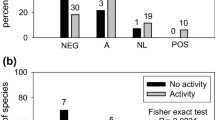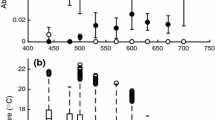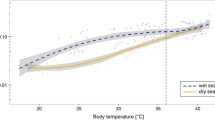Abstract
Thermal reaction norms are fundamental relationships for geographic comparisons of organism response to temperature. They are shaped by an organism’s environmental history and provide insights into both the global patterns of thermal sensitivity and the physiological mechanisms underlying temperature response. In this study we conducted the first measure of the thermal reaction norm for feeding, comparing the radula rasping rate of two tropical and one polar limpet species. The consistency of thermal response was tested through comparisons with limpet duration tenacity. Feeding and duration tenacity of limpets are ecologically important muscular mechanisms that rely on very different aspects of muscle physiology, repeated concentric (shortening) and isometric (fixed length) contraction of muscles, respectively. In these limpets the thermal reaction norms of feeding limpets were best described by a single break point at a maximum temperature with linear declines at higher (Siphonaria atra) or lower temperatures (Nacella concinna and Cellana radiata) rather than a bell-shaped curve. The thermal reaction norms for duration tenacity were similar in the two tropical limpets. However, the rasping rate in Antarctic N. concinna increased linearly with temperature up to a maximum at 12.3 °C (maximal range 8.5–12.3 °C) when feeding stopped. In contrast, duration tenacity in N. concinna was maximal at 1.0 °C (−0.6 to 3.8 °C) and linearly decreased with increasing temperature. The thermal reaction norms of muscular activity were, therefore, inconsistent within and between species, indicating that different mechanisms likely underlie different aspects of species sensitivities to temperature.





Similar content being viewed by others
References
Alto BW, Wasik BR, Morales NM, Turner PE (2013) Stochastic temperatures impede RNA virus adaptation. Evolution 67:969–979
Angilletta MJ (2009) Thermal adaptation. Oxford University Press, New York
Barry JP, Baxter CH, Sagarin RD, Gilman SE (1995) Climate-related, long-term changes in a California intertidal community. Science 267:672–675
Boyden CR, Zeldis JR (1979) Preliminary observations using an attached microphonic sensor to study feeding behaviour of an intertidal limpet. Estuar Coast Mar Sci 9:759–769
Bozinovic F, Calosi P, Spicer JI (2011) Physiological correlates of geographic range in animals. Annu Rev Ecol Evol Syst 42:155–179
Calosi P, Bilton DT, Spicer JI, Votier S, Atfield A (2010) What determines a species geographical range? Thermal biology and latitudinal range size relationships in European diving beetles (Coleoptera: Dytiscidae). J Anim Ecol 79:194–204
Chown SL, Jumban KR, SØrensen JG, Terblanche JS (2009) Phenotypic variance, plasticity and heritability estimates of critical thermal limits depend on methodological context. Funct Ecol 23:133–140
Clark TD, Sandblom E, Jutfelt F (2013) Aerobic scope measurements of fishes in an era of climate change: respirometry, relevance and recommendations. J Exp Biol 216:2771–2782
Davenport J, Wong TM (1992) Effects of temperature and aerial exposure on three tropical oyster species, Crassostrea belcheri, Crassostrea iredaelei and Saccostrea cucullata. J Therm Biol 17:135–139
Davis WJ, Mpitos GJ, Siegler MVS, Pinneo JM, Davis KB (1974) Substrates of behavioural hierarchies and associative learning in Pleurobranchaea. Am Zool 14:1037–1050
Gaston KJ, Chown SL, Calosi P, Bernado J, Bilton DT, Clarke A, Clusella-Trullas S, Ghalambor CK, Konarzewski M, Peck LS, Porter WP, Pörtner HO, Rezende EL, Schulte PM, Spicer JI, Stillman JH, Terblanche JS, van Kleunen M (2009) Macrophysiology: a conceptual reunification. Am Nat 174:595–612
Gillooly JF, Brown JH, West GB, Savage VM, Charnov EL (2001) Effects of size and temperature on metabolic rate. Science 293:2248–2251
Grenon J-F, Walker G (1981) The tenacity of the limpet, Patella vulgata L.: an experimental approach. J Exp Mar Biol Ecol 54:277–308
Hochachka PW, Somero GN (2002) Biochemical adaptation: mechanism and process in physiological evolution. Oxford University Press, New York
Horn PL (1986) Energetics of Chiton pelliserpentis (Quoy & Gaimard, 1835) (Mollusca: Polyplacophera) and the importance of mucus in its energy budget. J Exp Mar Biol Ecol 101:119–141
Huey RB, Kingsolver JG (1989) Evolution of thermal sensitivity of ectotherm performance. TREE 4:131–135
Karl TR, Nicholls N, Gregory J (1997) The coming climate. Sci Am 276:79–83
Kearney M, Porter WP, Williams C, Ritchie S, Hoffmann AA (2009) Integrating biophysical models and evolutionary theory to predict climatic impacts on species’ ranges: the dengue mosquito Aedes aegypti in Australia. Funct Ecol 23:528–538
Lai C-H, Morley SA, Tan KS, Peck LS (2011) Thermal niche separation in two sympatric tropical intertidal Laternula (Bivalvia: Anomalodesmata). J Exp Mar Biol Ecol 405:68–72
Liddiard KJ, Hockridge JG, Macey DJ, Webb J, Van Bronswijk W (2004) Mineralisation in the teeth of the limpets Patelloida alticostata and Scutellastra laticostata (Mollusca : Patellogastropoda). Molluscan Res 24:21–31
Mora C, Moya MF (2006) Effect of the rate of temperature increase of the dynamic method on the heat tolerance of fishes. J Therm Biol 31:337–341
Morley SA, Lemmon V, Obermüller BE, Spicer JI, Clark MS, Peck LS (2011) Duration tenacity: a method for assessing acclimatory capacity of the Antarctic limpet, Nacella concinna. J Exp Mar Biol Ecol 399:39–42
Morley SA, Martin SM, Day RW, Ericson J, Lai C-H, Lamare M, Tan KS, Thorne MAS, Peck LS (2012a) Thermal reaction norm and the scale of temperature variation in intertidal Nacellid limpets to climate change. PLoS One 7:e52818
Morley SA, Martin SM, Bates AE, Clark MS, Ericson J, Lamare M, Peck LS (2012b) Spatial and temporal variation in the heat tolerance limits of two abundant Southern Ocean invertebrates. Mar Ecol Prog Ser 450:81–92
Nguyen KDT, Morley SA, Lai C-H, Clark MS, Tan KS, Bates AE, Peck LS (2011) Upper temperature limits of tropical marine ectotherms: global warming implications. PLoS One 6:e29340
Peck LS (2005) Prospects for survival in the Southern Ocean: vulnerability of benthic species to temperature change. Antarctic Sci 17:497–507
Peck LS (2011) Organisms and responses to environmental change. Mar Genomics 4:237–243
Peck LS, Convey P, Barnes DKA (2006) Environmental constraints on life histories in Antarctic ecosystems: tempos, timings and predictability. Biol Rev 81:75–109
Peck LS, Clark MS, Morley SA, Massey A, Rossetti H (2009) Animal temperature limits and ecological relevance: effects of size, activity and rates of change. Funct Ecol 23:248–256
Peck LS, Morley SA, Richard J, Clark MS (2014) Acclimation and thermal tolerance in Antarctic marine ectotherms. J Exp Biol 217:16–22
Pennisi E (2005) What determines species diversity? Science 309:90
Petraitis PS (1992) Effects of body size and water temperature on grazing of four intertidal gastropods. Aus J Ecol 17:409–414
Pörtner HO, Farrel AP (2008) Physiology and climate change. Science 322:690–692
Pörtner HO, Knust R (2007) Climate change affects marine fishes through the oxygen limitation of thermal tolerance. Science 315:95–97
Pörtner HO, Peck LS, Somero GA (2007) Thermal limits and adaptation in marine Antarctic ectotherms: an integrative view. Phil Trans Roy Soc 362:2233–2258
Prosser CL (1973) Comparative animal physiology, 3rd edn. Saunders, Philadelphia
Richard J, Morley SA, Thorne MAS, Peck LS (2012) Estimating long-term survival temperatures at the assemblage level in the marine environment: towards macrophysiology. PLoS One 7:e34655
Sagarin RD, Barry JP, Gilman SE, Baxter CH (1999) Climate-related change in an intertidal community over short and long time scales. Ecol Monogr 69:465–490
Sanchez-Fernandez D, Aragón P, Bilton DT, Lobo JM (2012) Assessing the congruence of thermal niche estimations derived from distributions and physiological data. A test using diving beetles. PLoS One 7:e48163
Sinclair ELE, Thompson MB, Seebacher F (2006) Phenotypic flexibility in the metabolic response of the limpet Cellana tramoserica to thermally different microhabitats. J Exp Mar Biol Ecol 335:131–141
Sunday JM, Bates AE, Dulvy NK (2011) Global analysis of thermal tolerance and latitude in ectotherms. Proc Roy Soc Lond B 278:1823–1830
Terblanche JS, Deere JA, Clusella-Trullas S, Jannion C, Chown SL (2007) Critical thermal limits depend on methodological context. Proc Roy Soc Lond B 274:2935–2942
Waller CL, Worland MR, Convey P, Barnes DKA (2006) Ecophysiological strategies of Antarctic intertidal invertebrates faced with freezing stress. Pol Biol 29:1077–1083
Zeileis A, Leisch F, Hornik K, Kleiber C (2002) Strucchange: an R package for testing for structural change in linear regression models. J Stat Soft 7:1–38
Acknowledgments
This research was funded by NERC funding to the British Antarctic Survey’s Polar Science for Planet Earth, Adaptations and physiology work package and Singapore Research Council grant 0821010024. The authors acknowledge the support of the Rothera marine team and the NERC Scientific Diving Facility.
Author information
Authors and Affiliations
Corresponding author
Additional information
Communicated by H.V. Carey.
Electronic supplementary material
Below is the link to the electronic supplementary material.
Rights and permissions
About this article
Cite this article
Morley, S.A., Lai, CH., Clarke, A. et al. Limpet feeding rate and the consistency of physiological response to temperature. J Comp Physiol B 184, 563–570 (2014). https://doi.org/10.1007/s00360-014-0814-3
Received:
Revised:
Accepted:
Published:
Issue Date:
DOI: https://doi.org/10.1007/s00360-014-0814-3




